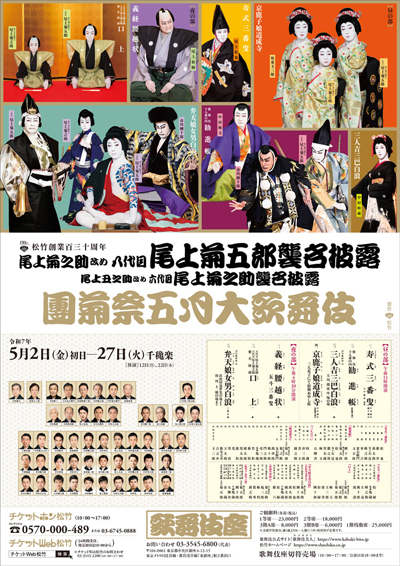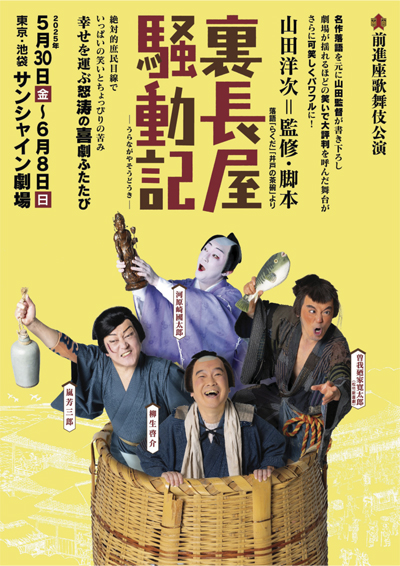| MAY 2025 |
|
4 shows in T˘ky˘ (Kabukiza, Asakusa K˘kaid˘, Sunshine Theatre), 4 in ďsaka (Sh˘chikuza, Expo Hall), 1 in Ky˘to (Minamiza) & 1 tour (Shinryoku Special Tour)!
|
| Kabukiza (T˘ky˘) |  |
| Dates | 2 ~ 27 May 2025 Dankikusai Gogatsu ďkabuki Dankikusai May Grand Kabuki |
| MatinÚe |
Sannin Kichisa Tomoe no Shiranami Ky˘ganoko Musume D˘j˘ji |
| Evening |
Yoshitsune Koshigoej˘ (Goto Sanba) Benten Musume Meo no Shiranami
|
| Casting |
Living National Treasure Onoe Kikugor˘, Living National Treasure Band˘ Tamasabur˘, Living National Treasure Nakamura Baigyoku, Living National Treasure Nakamura Karoku, Onoe Kikugor˘, Onoe Kikunosuke, Nakamura Manju, Ichikawa Danjűr˘, Nakamura Jakuemon, Nakamura Kinnosuke, Onoe Sh˘roku, Band˘ Rakuzen, Nakamura Matagor˘, Onoe Matsuya, Onoe Ukon, Ichikawa Udanji, Nakamura Tokiz˘, Band˘ Hikosabur˘, Ichikawa Monnosuke, Band˘ Kamez˘, Kataoka Ichiz˘, Kataoka Kamez˘, Nakamura Kotar˘, Nakamura Yonekichi, Nakamura Kash˘, Nakamura Mantar˘, Nakamura Tanenosuke, Ichikawa Kudanji, ďtani Tomoemon, Ichimura Manjir˘, Kawarasaki Gonjűr˘, Band˘ Shingo, Nakamura Takanosuke, Nakamura Kangyoku, Ichikawa Omez˘, Ichikawa Shinnosuke, Onoe Maholo, ďtani Hirotar˘, ďtani Hiromatsu, Ichimura Takematsu, Onoe Sakon, Band˘ Kamesabur˘, Nakamura Baishi, Ichikawa Otora, Nakamura Tamatar˘, Ichimura Hikaru, Nakamura Kichinoj˘, Nakamura Kamenoj˘, Ichimura Kitsutar˘ |
| Comments |
A great shűmei in May 2025 at the Kabukiza for the Otowaya guild! Onoe Kikunosuke V and his son Onoe Ushinosuke VII respectively take the names of Onoe Kikugor˘ VIII and Onoe Kikunosuke VI!
|
 |
 |
 |
 |
 |
| Sh˘chikuza (ďsaka) |  |
| Dates | 11 ~ 25 May 2025 Kunpű Kabuki Tokubetsu K˘en Summer Breeze Kabuki Special Performances |
| 1st program |
Konjaku Kabuki Z˘shi Mus˘ Saiyűki |
| 2nd program |
Sen'ya Ichiya Monogatari (Arajin no Maki) |
| 3rd program |
Waki Noboru Mizu-ni Koi Taki (Koi Tsukami) |
| Casting |
Nakamura Ganjir˘, Kataoka Ainosuke, Nakamura Senjaku, Ichikawa Chűsha, Nakamura Kazutar˘, Kamimura Kichiya, Ichikawa Emisabur˘, Ichikawa Emiya, Ichikawa En'ya, Nakamura Kikaku, Nakamura Toranosuke, Nakamura Hashinosuke, Nakamura Fukunosuke, Nakamura Utanosuke, Ichikawa Seiko, Nakamura Jűjir˘ |
| Comments |
Special Kabuki performances in ďsaka at the Sh˘chikuza to celebrate the 2025 World Exposition in ďsaka.
|
 |
 |
| Shinryoku Special Tour | |
| Dates | 3 ~ 25 May 2025 Shinryoku Kabuki Tokubetsu K˘en Fresh Greenery Kabuki Special Performances |
| Program |
T˘ku & Mini Kabuki-juku |
| Casting |
Nakamura Kankur˘, Nakamura Shichinosuke, Nakamura Tsurumatsu |
| Comments |
A Spring Tour of the Nakamuraya guild with performances in 16 venues.
|
 |
|
|
| Dates | 15 ~ 24 May 2025 Kabuki Kansh˘ Ky˘shitsu Kabuki Appreciation Class |
| Program |
Kabuki no Ohanashi |
| Casting |
Kamimura Kichitar˘, Kataoka Senju |
| Comments |
Young actors performing in Ky˘to at the Minamiza.
|
 |
 |
|
|||
| Dates | 1 ~ 2 May 2025 Kamiyach˘ Sh˘kabuki Kamiyach˘ Little Kabuki |
||
| Program |
Goaisatsu
|
||
| Casting |
Nakamura Hashinosuke, Nakamura Fukunosuke, Nakamura Utanosuke, Arashi Kitsusabur˘ |
||
| Comments |
3rd edition of a gala for Nakamura Shikan's three sons. It is entitled Kamiyach˘ Sh˘kabuki ('Kamiyach˘ Little Kabuki'). Kamiyach˘ was the name of late Nakamura Shikan VII's neighboorhood in T˘ky˘ and it was used as an original way to appraise this great actor (kakegoe).
|
||
 |
| Expo Hall (ďsaka) |  |
| Dates | 10 May 2025 Kamigata Dent˘ Gein˘ K˘en Kamigata Traditional Arts Performances |
| Program |
Sanbas˘ Hagoromo Hana Kis˘ Satsuki no Esugata
|
| Casting | |
| Comments |
Special Traditional Arts in ďsaka at the Expo Hall of the 2025 World Exposition to celebrate the opening of the World Exposition in ďsaka. |
 |
| Sunshine Theatre (T˘ky˘) |
| Dates | 31 May ~ 8 June 2025 Zenshinza Kabuki K˘en Zenshinza Kabuki Performances |
| Program |
Ura Nagaya S˘d˘ki |
| Casting |
Kawarasaki Kunitar˘, Arashi Yoshisabur˘, Soganoya Kantar˘, Yagyű Keisuke & others |
| Comments |
The usual Zenshinza Spring program, not at the National Theatre (closed) but at the Sunshine Theatre (T˘ky˘)! "Ura Nagaya S˘d˘ki", which was written by the veteran movie director Yamada Y˘ji and was premiered in May 2017 at the National Theatre, is based on two famous rakugo stories, "Rakuda" and "Ido no Chawan". The guest star is the Shinkigeki actor Soganoya Kantar˘. |
 |
|
|
| Contact | Main | Top | Updates | Actors | Plays | Playwrights | Programs | Links | FAQ | Glossary | Chronology | Illustrations | Prints | Characters | Derivatives | Theaters | Coming soon | News |